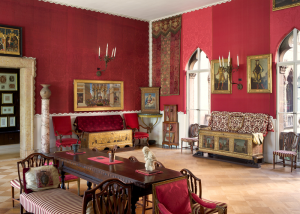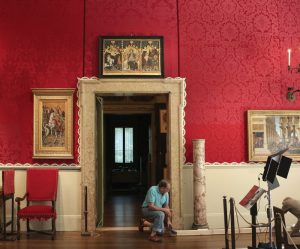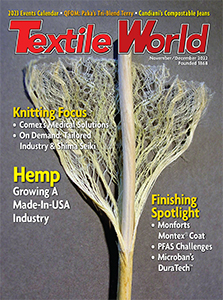Reproductions of textiles originally covering the walls of the Raphael Room at the Isabella Stewart Gardner Museum have been installed to restore the gallery to its circa-1924 appearance.
By Janet Bealer Rodie, Contributing Editor
Over several decades, extensive work has gone into restoring the galleries of the Isabella Stewart Gardner Museum in Boston to their look at the time of Gardner’s death in 1924. The museum, built in the style of a 15th-century Venetian palace, opened in 1903 to house her extensive collection of paintings, sculptures, textiles, furniture and other items collected around the world and created over a 30-century span. Three floors of exhibition space in light-filled galleries are arranged around an interior courtyard garden.
In the Raphael Room on the second floor, textiles covering the walls and upholstered furniture are a major part of the restoration, which is nearly complete. Gardner had collected a number of 17th- and 18th-century Italian and Spanish silk damask and velvet fabrics, and she used 18 damasks and two velvets to cover the walls in that room, piecing them together in a patchwork-like way. The original fabrics were replaced in the 1950s, and now, those newer fabrics, sagging and faded after 60 years, have been replaced with reproductions of the original fabrics.
The Gardner archives had only a few original fabrics, so Tess Fredette, senior textile conservator at the museum, and her team researched 1926-era photographs of the room and archives from other museums. She then worked with a designer, weaving technician and others at commision silk weaver Prelle et Cie, Lyon, France, to execute the reproduction of each fabric. “I was able to sit with the woman who designed the patterns on the CAD system and talk to the weaver to decide what looms to use to weave the fabric, and decide how best to do that in a very cost-effective way,” she said.
Prelle成立于1752年,现在是第五代家族企业,最初专门从事Handwoven,Custom Damask,Brocade和Velvet Fabrics。如今,它可以利用手工织机和高科技工业织机,再现历史悠久的织物并编织了新的高端定制织物,用于内部和Couturier应用。
The original fabrics were various shades of red. “Chances are that in the late 17th-early 18th century the palette for red was fairly tight, but except for the few samples that we had, we really didn’t know the shades of red,” Fredette said. “They were basically a burgundy or bordeaux kind of red, so we came up with a color scheme, making the palette tight but having the fabrics look slightly different by choosing two different-colored warps and two different-colored wefts. We also had two different weft yarns, one aBombyx丝绸和另一种是Tussah丝绸,所以只有这四种染料和两种纱线类型,我们就可以在这个小而紧的调色板中创造出一些品种。”
对于拉斐尔室,Prelle建立了两个Dornier电子织机,并用两个扭曲编织所有锦缎图案,另一个织机来编织天鹅绒。总共编织了300码的织物。
In addition to the fabrics reproduced by Prelle, there are other fabrics that museum staff replicated in-house. Textile conservator Elsbeth Dijxhoorn re-created bands of linen embroidered with silk chenille emulating tasseled fringe to use on three velvet-covered stools in the room. The chenille was dyed to match the original colors found in a seam on the original bands.

Also, Fredette speculates that some of the original velvets on the walls had once had floral appliqués on them, but not when Gardner collected them. Where appliqués had fallen off, the tight stitching that had been used to attach them had left impressions on the fabric. “So to emulate the floral impressions left by missing appliqués, we had the new velvets embossed in-house,” Fredette said. The rubber embossing stamps were hand-carved by fiber artist Emma Welty.
弗雷德特(Fredette)和她的团队与波士顿软墙协会的所有者布鲁诺·乔恩(Bruno Jouenne)合作,组装了各种墙壁面料和修剪,并将其安装在画廊的墙壁上。弗雷德特说:“看来原始面料被缝在一起。”“我在纸上绘制了它,并将其与历史照片进行了比较。因为一切都是如此拼凑,所以我们会切成织物,悬挂在墙壁上,然后向后看。然后,每件作品都被拆除了,它们都被缝在一起,以使墙壁大小的大布。然后将其重新安装在墙壁上,只是在周围张紧。”
为了复制墙壁和窗框上的某些细节,博物馆委托了六个定制的丝绸饰边,由纽约市的塞缪尔(Samuel&Sons)以及来自巴黎的Passementerie Verrier的四个手工编织的丝绸雪尼尔饰边。
All of the fabrics are 100-percent silk, so to satisfy Boston’s fire codes, the museum lined the walls with Velos II flame-retardant Trevira CS polyester napped velour fabric produced by Création Baumann, Switzerland. The Velos II was hung upside down to take advantage of the nap angle as a means to hold the silk fabrics in place and mitigate their sagging over time.
For more information about the textile restoration at the Isabella Stewart Gardner Museum, contact Sarah Whitling swhitling@isgm.org; gardnermuseum.org.
July/August 2017





